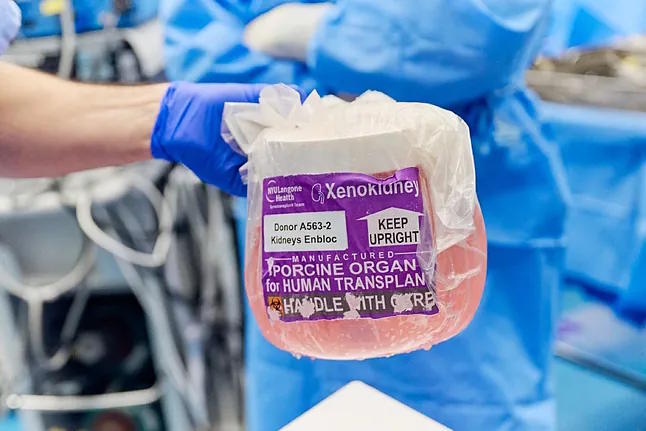For the first time, a team of Chinese researchers has performed an auxiliary pig liver transplant, which was genetically modified, on a patient. The recipient survived 171 days, and the transplanted liver showed it could contribute to key metabolic and synthetic functions in the human body but had to be removed from the patient after 38 days due to a serious complication.
"This case demonstrates that a genetically modified pig liver can function in a human for an extended period," stated lead researcher Beicheng Sun from the Department of Hepatobiliary Surgery and President of the First Affiliated Hospital of Anhui Medical University in Hefei, China. "It is a crucial step showing both the possibilities and the remaining obstacles, particularly those related to coagulation dysregulation and immune complications that need to be overcome."
The case is reported today, Thursday, in the medical journal Journal of Hepatology. The xenotransplant was performed on a 71-year-old man with cirrhosis associated with hepatitis B and hepatocellular carcinoma, who was not eligible for surgical resection or liver transplant.
The transplanted liver came from a miniature pig species that were altered with ten modifications to silence certain genes and introduce others to prevent rejection and improve immune and coagulation compatibility with humans. The procedure involved an auxiliary transplant, which does not require the patient's liver to be removed to receive the graft and is designed as a bridge therapy, a way to buy time for the patient until another treatment.
During the first month after surgery, the graft functioned well, producing bile and synthesizing coagulation factors without evidence of acute or hyperacute rejection. However, on day 38, the graft had to be removed due to the development of thrombotic microangiopathy associated with xenotransplantation, a coagulation disorder that leads to tissue necrosis. Although the patient responded to treatment with the complement inhibitor eculizumab and plasma exchange, new episodes occurred, a gastrointestinal hemorrhage ensued, and ultimately, the patient passed away almost six months after receiving the graft.
This is not the first pig liver xenotransplant to a human, but it is the first for therapeutic purposes, as highlighted by SMC Spain's Beatriz Domínguez-Gil, Director of the National Transplant Organization (ONT), as previous cases in China and the United States were performed on individuals in brain death, "where the possibility to evaluate graft function is limited in time."
"This represents a new step in the advancement of xenotransplant therapy, which continues to progress in its clinical development, but also evidence of the significant obstacles that still need to be overcome, such as the serious complication observed in this patient," Domínguez-Gil asserts.
While these interventions have only been conducted experimentally or compassionately, xenotransplants are gradually advancing. Earlier this year, the U.S. FDA approved the first clinical trial to evaluate the use of genetically modified pig kidneys in humans.
However, the ONT Director emphasizes the experimental nature of these transplants. "Efforts must continue to refine the genetic modifications made, improve the immunosuppression used, and try to identify and address complications that may develop early on." She notes that "ideally, this should be done in properly designed clinical trials to assess their efficacy and safety in the short, medium, and long term. Nevertheless, these cases allow us to envision a future where xenotransplantation becomes a clinical reality as a bridge therapy (particularly in the case of the liver) or as a destination therapy."
She also mentions that in 2024, in Europe, out of a total of 22,215 patients on the waiting list for a liver transplant, only 11,019 patients received one, according to data from the Global Observatory on Donation and Transplantation managed by the National Transplant Organization (ONT) as a collaborating center of the World Health Organization. "Additionally, in these countries, 2,314 patients died while on the waiting list for a liver transplant."
